

Wayne Schmidt's Vanilla Pudding Page Taste comparisons of ready-made, instant, and cooked vanilla puddings. How to make the world's best vanilla pudding.
Few
flavors are more likely to conjure a yawn than vanilla. The very
word has become synonymous with bland and boring. Yet this humble
flavoring is the third most widely used in the world, ranking just
below sugar and salt. Vanilla is found in virtually every baked good,
is important in chocolate making and used in cuisines throughout the
world. While its primary use is to mellow and enhance the flavors of
other ingredients, it comes into its own in those two great
gastronomic delights: vanilla ice cream and vanilla pudding.
The page is about vanilla pudding, that seductively smooth and delicious dessert that has fallen into low repute in recent years. That fault lies not with the dish itself but with the multitude of poor quality ready-made puddings and instant mixes that are all that most people know of this unrivaled treat. Come with me as I explore the good, the bad and the ugly of vanilla puddings and develop what I think is the best vanilla pudding recipe in the world.
Before making our own from scratch, let's compare ready-made, instant and cooked mixes to see if any of them come close to a truly great home made vanilla pudding.
Ready-Made
Pudding Cups:
The five grocery stores in my town provided four different brands:

Ralph's (thick, eggy and dyed a offensively bright yellow,) Kraft (gray color, soupy, odd aromatic chemical taste,) Hunts (too thick, caramely flavor, too yellow and starchy,) and Swiss Miss (the only one requiring refrigeration: perfect texture, good vanilla flavor, slightly starchy but by far the best of the four.)
While the Swiss Miss brand was the clear winner, it still lacked the rich depth of flavor the best vanilla puddings offer.
Important Update!!! Shortly after creating this page I noticed Swiss Miss started marketing a new version of their vanilla pudding named "Indulgent Collection: Creamy Vanilla." I tested it and found it to be greatly inferior to their original recipe. This new version has a strong caramely, malty note to its flavor that I found unpleasant. These flavor elements are so pronounced it's hard to taste any vanilla.
Sugar
Free Ready Made Cups:
Although this page is about quality and isn't intended to explore so-called "healthy alternatives," I decided to test some sugar-free and fat-free puddings for the sake of completeness.

Hunt's sugar-free vanilla pudding had a terrible chemical edge that was disgusting. Jell-O brand sugar-free pudding was better but still had a slight sour edge to it. Neither of these were as good as any of the four previous ready-made puddings.
Fat-Free
Ready-Made Vanilla Pudding:
The only brand I found in this category was Hunt's.
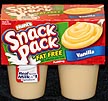
In spite of it's grayish color, which I found to be a put-off, it was better than either of the sugar-free offerings. However, it still had a chemical edge that left a sour note on the palate.
Instant
Mixes: (All made with whole milk as per the
directions on each box.)

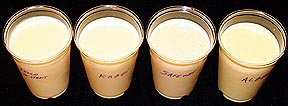
From left to right: The Jell-O brand was the best with a creamy texture and very good vanilla flavor. It's biggest problem was that it was far too yellowish. Kroger had a weak vanilla flavor and a sour edge. Safeway was foamy and bland. Albertson's was too yellow and had a strong artificial vanilla flavor.
The Jell-O brand vanilla pudding was quite good, better than the Swiss Miss.
French
Vanilla Instant Mixes:
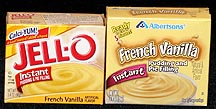

Jell-O French Vanilla pudding was too yellow and edgy from too much vanilla flavoring. Albertson's was too thick and had a sour flavor. It was one of the worst.
Albertson's
Sugar-Free and Fat-Free:
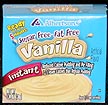

This was one of the worst things I've ever tasted. Multiple bad flavors fought to see which could be the most offensive. It was sour and had a vile chemical edge that sent me running for water to wash the taste away.
Cook
and Serve Mixes:
The only mix I could find in this category was Jell-O.

It had a strong caramel flavor and sour notes that made it quite bad. The Jell-O instant mix was much better.
Milk
Options:
After establishing that the Jell-O instant mix was the best packaged vanilla pudding, I made additional batches of it using non-fat milk, 1-percent, 2-percent, whole, half and half, and whole cream to see how these milk options effected taste and texture.

From left to right: the non-fat, 1-percent and 2-percent milks produced puddings that had a slightly translucent appearance and a weak gelatinous texture that lacked the rich smoothness one expects from good vanilla pudding. Whole milk produced the best results. The half and half and cream were too thick and buttery. The cream in particular had a coarse, grainy texture. Also, the half and half and cream-based puddings were too white.
While the half and half was too thick, it never the less added an interesting richness to the pudding. I made one more batch of the Jell-O vanilla pudding using 3-parts whole milk and 1-part half and half with the idea of producing something that had whole milk's texture with half and half's flavor. It didn't work. The resulting pudding was still too thick and the improvement in flavor was marginal.
Time
to Get Serious - Home Made Vanilla Pudding:
There are two ways to thicken puddings: adding a starch or eggs.
After several experiments I found that puddings thickened only with eggs are usually baked and called custards. While many excellent custard recipes are available, my emphasis is on stove-top preparation. Besides, custards don't have the uniformly smooth, creamy texture I expect from a pudding. The problem with making vanilla pudding with only eggs as the thickening agent is that to get the pudding to the proper consistency two or more eggs are required per cup of milk. This results in a pudding that tastes too eggy. If the sugar and vanilla are increased to mask this, the pudding takes on an edgy flavor. For this reason all of the recipes that follow use a starch for thickening. Eggs are included primarily for flavor.
The next question is: Which thickening starch is best? Powdered tapioca creates puddings with a slimy gelatinous texture. Similarly, other thickeners like potato starch, arrowroot, etc, also add off-flavors or odd textures. For my money the best thickener is corn starch. It provides a creamy, smooth texture and a high gloss that makes the pudding look delicious.
After testing many different recipes, the best vanilla pudding I found in cookbooks and on-line was the following:
2-cup of whole milk
2-egg yolks
1/3-cup of sugar
2-tablespoons
of corn starch
1/8-teaspoon
of salt
2 teaspoon of
real vanilla
I began developing my own optimized recipe by trying three variations: using egg whites instead of yolks, adding 2-tablespoons of butter after cooking, and increasing the number of yolks to four.

The cup on the left is the basic recipe. It was very good with just the right amount of sugar but had a little too much vanilla that gave it an edge. It was also a little thin. Next over is the test using only egg whites. It was unattractively white and translucent, had a rubbery texture and eggy flavor. Third from the left was the recipe with the butter. It was slightly firmer (which surprised me) and had a deeper, richer flavor. The batch on the far right with four egg yolks was too thick and eggy.
These results suggest that cutting the vanilla in half, adding the butter, and increasing the egg yolks to 3 should yield the best results. To test this conclusion I made it as well as one batch with the vanilla cut to 3/4 of the basic recipe. I also added two drops of yellow food color to this one. The goal wasn't to make the pudding look artificially yellow but to counteract the graying effect vanilla has on the pudding's final color.

The result was that the batch with the vanilla reduced to 1/2, on the left, was the best. It had a strong vanilla flavor without being so overpowering that it started to burn. But, the added food coloring of the losing batch improved that pudding's appearance so much I added it to the final recipe.
The final recipe is:
2-cups of
whole milk
1/3-cup of sugar
3 egg yolks
2-tablespoons
of corn starch
1/8-teaspoon
of salt
2-tablespoons
of butter
1-teaspoon
real vanilla (Feel free to reduce this if the pudding is too strong
for you.)
2-drops of
yellow food color
Stir the egg yolks
with a whisk to break them up. Whisk with 1/4-cup of the milk to
help them strain through a fine-mesh strainer to get any bits of egg
white. Mix this strained egg mixture into the remaining milk in a
sauce pan. Add the sugar, cornstarch and salt. Cook, whisking
constantly, over medium heat until it comes to a simmer. Whisk in the
butter and vanilla just until the butter is completely incorporated,
about 30-seconds. I usually turn the heat down a little at this point
so the pudding doesn't overcook. It's necessary to simmer the mixture
after adding the vanilla to drive off the extract's alcohol. Failure
to do so will leave the pudding with a harsh alcohol note.
Immediately pour into four dessert cups. Cover with plastic wrap
pushed down onto the surface of the pudding to prevent it from
forming a skin and cool in a refrigerator until it's chilled.
Serve, eat, and smile: Ahhh... life is good.
Which Vanilla Is Best?

I made batches of pudding using the artificial vanilla, standard vanilla, Tahitian vanilla, Madagascar vanilla and Mexican vanilla (from beans grown in Mexico but processed in the US to avoid adulteration with cheaper tonka beans and the dangerous chemicals that sometimes get introduced into Mexican vanilla) to see which was best. The artificial vanilla produced a bland taste that while not bad, wasn't very interesting. The standard (Shilling) vanilla made a very good pudding. The Tahitian vanilla introduced a very interesting pudding with a light, high note to the flavor that I liked, but also added a fruity, cherry-like flavor that was distracting. The Madagascar vanilla produced a deep, rich, mellow pudding as did the US vanilla made from Mexican beans. I'd have to say the the Mexican was the best but the truth is that I'd be hard-pressed to tell the difference between the standard, Madagascar and Mexican vanilla. However, using the more exotic vanillas is definitely more fun.
I also tried a couple of batches using two whole vanilla beans (scrapped and added to the pudding before cooking) and found them very unsatisfactory. Even after straining out the pulp the seeds gave the pudding a gritty texture that was very unpleasant. Cooking the beans in milk and then straining out the seeds using a coffee strainer solved the grittiness problem but the pudding ended up with only a mild vanilla flavor and a odd, harsh aftertaste. One additional factor against using real vanilla beans is their expense. A small batch of pudding that's only enough for three people costs $15.00.
Final
Thoughts:
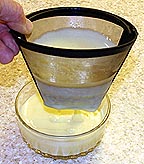
Straining the pudding is a messy complication that can cause the pudding to "break," where it doesn't completely set up firmly after chilling. I found that straining doesn't make the final pudding any smoother. It's important to get the hot pudding into the cups as quickly as possible and leave it undisturbed for a good set.
I found the yolks from large eggs to be the best. Those from extra-large or jumbo eggs gave the pudding too strong of an eggy flavor.
Using good utensils may not make a better pudding, but they make making it a lot more fun.

I like using a sauce pan with gently curved sides that have no sharp turns where ingredients can hide. A soft, heat-proof spatula who's curve fits the curve of the pan is also nice.
Be sure to keep whisking after the pan is taken off the heat. The pan has enough heat stored in it to cook lumps into the pudding even though there is no flame under it.
By all means experiment with this recipe to optimize it for your own particular tastes.
Avoid the temptation to dress up your pudding with toppings. Although this is excellent vanilla pudding its flavor is delicate and easily masked by other flavors. (Having said this I must confess that one of my favorite desserts is pour some still-hot pudding over a thick slice of Sara Lee pound cake. The two flavors complement each other perfectly.)
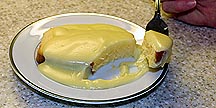
Don't add the
vanilla at the beginning of making the pudding or too much of its
flavor with evaporate.
Be careful when measuring cornstarch. It compresses very easily. Leveling a tablespoon by scraping it against the side of the container may pack it down so that instead of one tablespoon you really get two. This is the reason some people experience a batch-to-batch variation in how thick their pudding is. Developing a consistent measuring technique is critical to consistent pudding texture. (For increased consistency I weigh cornstarch. Two tablespoons is 16 grams.)
The vanilla pudding recipe produces an industrial strength pudding that may be too rich for some people. If so, try reducing the eggs yolks to 2, increasing the cornstarch to 3 tablespoons and reducing the butter to one tablespoon.
I hope you've enjoyed this page as much as I have putting it together. Please check back from time to time because I'll be adding updates and improvements to the recipe. Until then... good cooking!
(Click on main site to go to my main page and browse 70 topics ranging from triangle looms and Knitting Nancies to the strange world of lucid dreaming.)